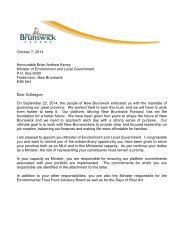cbd-ts-67-en
cbd-ts-67-en
cbd-ts-67-en
- No tags were found...
Create successful ePaper yourself
Turn your PDF publications into a flip-book with our unique Google optimized e-Paper software.
Impac<strong>ts</strong> of Marine Debris on Biodiversity: Curr<strong>en</strong>t Status and Pot<strong>en</strong>tial Solutions<br />
Annex 1:<br />
Information extracted from repor<strong>ts</strong> and<br />
publications in relation to docum<strong>en</strong>ted <strong>en</strong>counters<br />
betwe<strong>en</strong> marine debris and an organism<br />
An ext<strong>en</strong>sive literature review of data published prior to April 2012 in peer reviewed publications and repor<strong>ts</strong><br />
in grey literature was conducted for this review, and the following information was extracted:<br />
60<br />
Species name (sci<strong>en</strong>tific and common)<br />
Taxonomic grouping e.g. Mammals, Birds, Fish, Sea Turtles, Crustaceans, Cephalopods, Bivalves,<br />
Gastropods, Echinoderms, Cnidaria. As numbers of organisms from other taxonomic groups were low,<br />
subsequ<strong>en</strong>t reporting is focussed on Mammals, Birds, Fish, and Sea Turtles<br />
Number of individuals (for repor<strong>ts</strong> where this was not giv<strong>en</strong>, it has be<strong>en</strong> recorded as a nominal value of 1)<br />
Debris type e.g.: Metal, Plastic, Paper, Glass, Wood (other than driftwood), Other, Unknown (where the<br />
study did not report the debris type)<br />
For plastic debris which was the main material type reported, an additional category ‘Debris usage /<br />
type’ was recorded, e.g. Rope & Netting, Other Fishing Material, Intact Items and Packaging, Fragm<strong>en</strong><strong>ts</strong><br />
(> 5 mm), Microplastics (< 4.99 mm).<br />
Type of <strong>en</strong>counter e.g. ingestion, <strong>en</strong>tanglem<strong>en</strong>t, rafting<br />
Number of individuals docum<strong>en</strong>ted per species according to debris type (consequ<strong>en</strong>tly some individuals<br />
were recorded more than once if, for example, they had ingested two types of debris).<br />
Consequ<strong>en</strong>ce(s) of <strong>en</strong>counter: Direct Harm/Death, Indirect Harm/Death, Survived, Unknown (where<br />
the study stated that they did not know the fate of the individuals), or Not Reported<br />
Location: grouped according to region—North America West Coast, North America East Coast, South<br />
America West Coast, South America East Coast, C<strong>en</strong>tral South Atlantic, Europe, Africa West Coast,<br />
Africa East Coast, Asia, Australasia, C<strong>en</strong>tral Pacific, Arctic, Antarctic, Other, Unknown.<br />
Refer<strong>en</strong>ce to the source of the report



